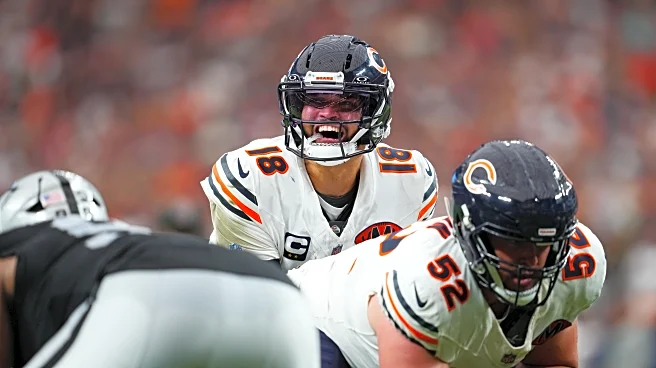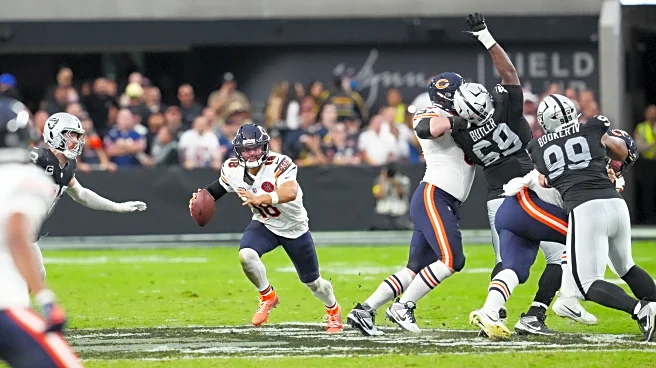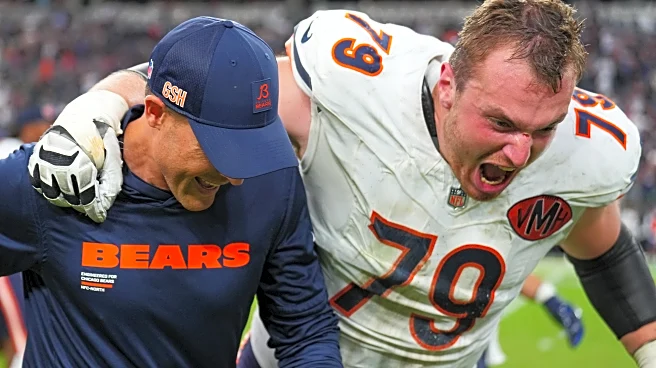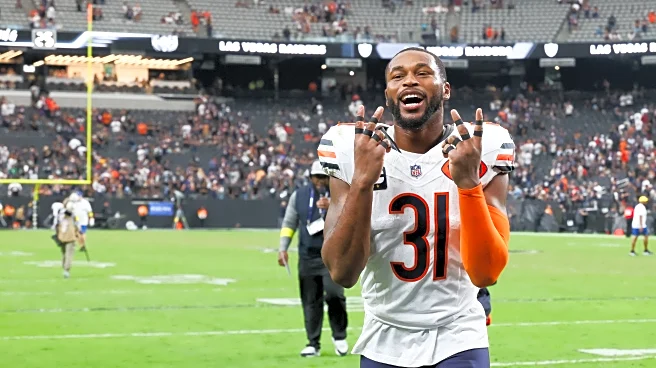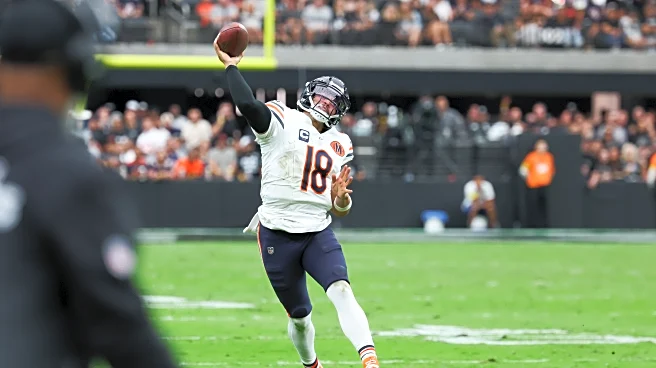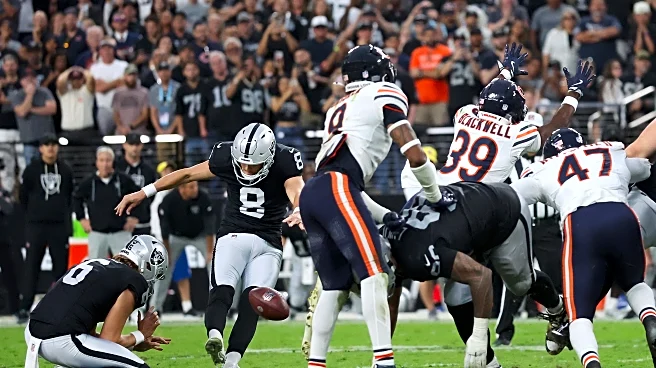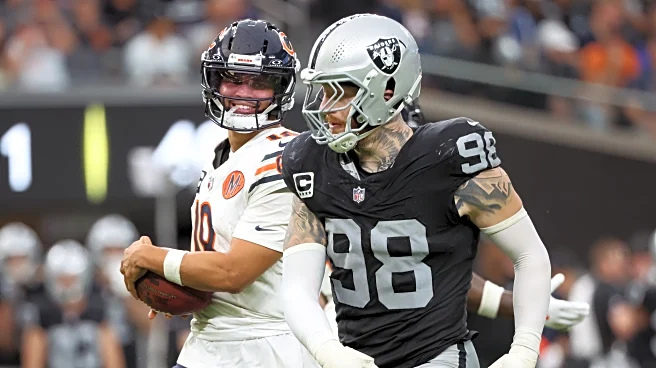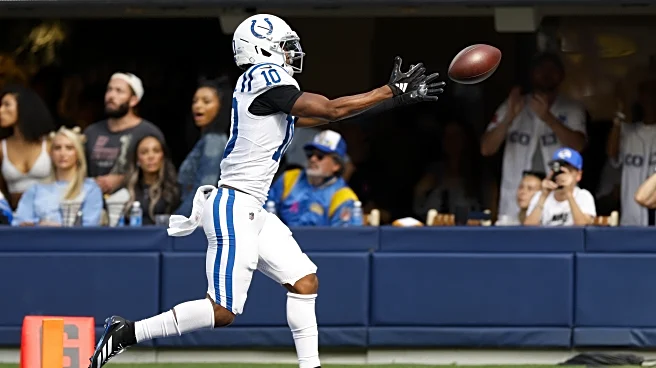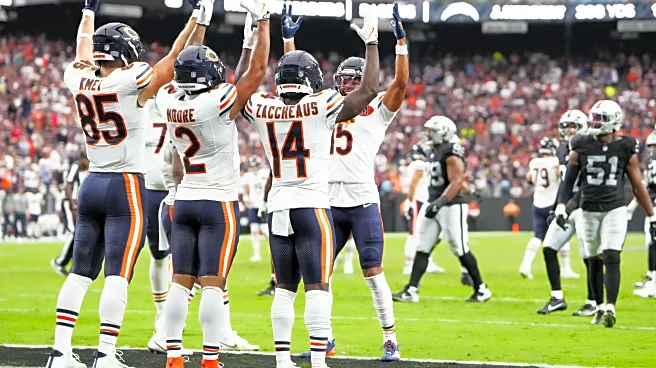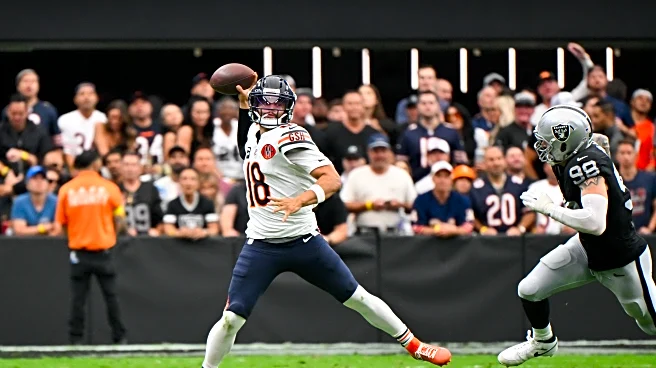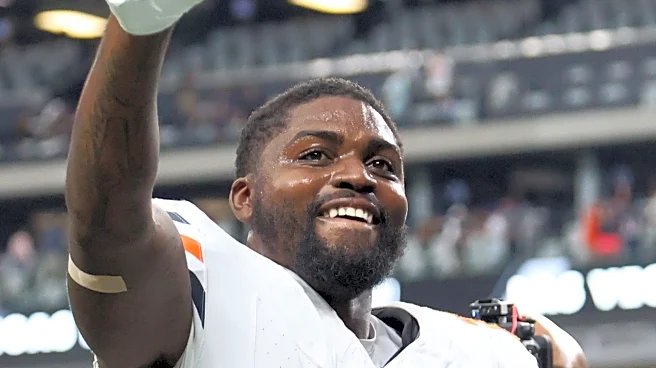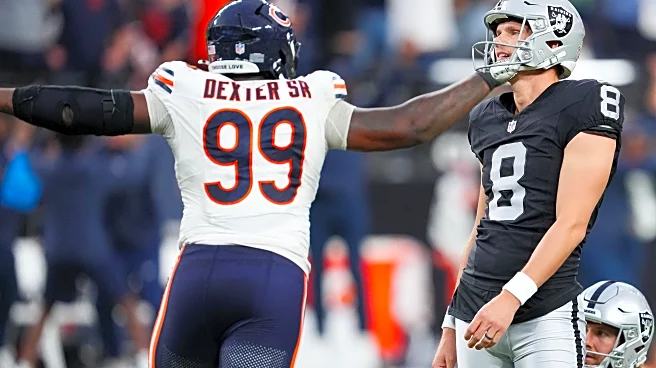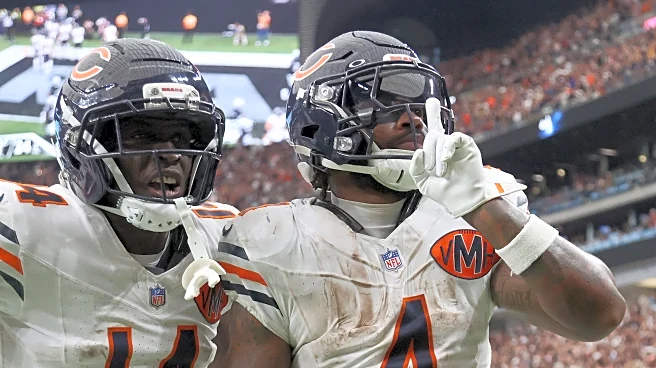Full disclosure: I thought this game would look a lot more like the Cowboys matchup, soft defense against a young offense ready to flex. But I didn’t account for three things: 1) the natural ebb and flow of the NFL season and its “any given week” chaos, 2) Maxx Crosby’s sheer ability to erase an offense from existence, and, 3) Growth is very often nonlinear.
For about three quarters, Crosby was operating on a completely different level. He turned the field into his personal playground and made the Bears,
specifically Caleb Williams, look like prey caught in the wrong habitat. It was relentless, it was suffocating, and it was the kind of performance that can flip a game script by itself.
Credit to the Bears, though. With some key adjustments up front, like benching Braxton Jones for Theo Benedet at left tackle and sliding rookie Ozzy Trapilo into the right tackle spot, they managed to blunt Crosby’s impact just enough. The offense, stagnant early, finally found its footing with two second-half touchdowns, capped by Williams orchestrating a game-winning drive. And fittingly, it was Josh Blackwell, who earned a NFC Special Teams Player of the Week nod, sealing the 25–24 win with a blocked field goal off the edge.
Yes, it’s fair to call this a step back for the offense overall. But there’s still plenty of silver lining. This team showed it can climb out of an early hole, something last year’s squad rarely managed. Caleb’s on-target throw rate keeps climbing, and while the first half was a safari where Crosby was the cheetah and Williams the unlucky gazelle (where have I heard that comparison before..), the second half was a reminder that this young quarterback can adapt, adjust, and deliver when it matters, and that maybe, the times are changing in Chicago with Ben Johnson at the helm.
So, let’s take a look at what we learned from week 4!
Benchmarks
(Season Averages in Italics)
C/A: 19.7/31 (63.5%) | 22/37 (59.5%)
Yards: 238.3 | 212
aDOT: 8.8 | 7.6
Touchdowns: 2.3 | 1
Turnovers: 0.3 | 1
QB at Fault Sacks: 1 | 0
Passer Rating: 107.6| 73.3
True Passer Rating: 142.4 | 104.1
Time to Throw: 3.04s | 3.03s
Time to Pressure: 2.62s | 2.61s
Pressure Rate: 30.77% | 31.82%
On-Target Rate: 62.5% | 63.4%
Poor Play Rate / Big Play Rate: 14.5% PPR / 8.9% BPR | 6.5% PPR / 4.2% BRP
Game Notes

The full grading sheet for each play can be found here.
- NFL Passer Rating / True Passer Rating / PFF Grade: 77.3 / 104.1 / 62.2
- On-Target Throws: Season Average: 62.5% | Week 4 against the Raiders: 63.4% Interestingly, there was actually a slight uptick in Caleb’s on-target throws compared to his season average. That caught me off guard, because watching live it certainly didn’t feel like he was sharper than usual. (Worth noting: I still need to finish charting Weeks 1 and 2, so that season average may dip a bit once those numbers are in, which would put this game in a different light during our next check-in.)
- 6.5% Poor Play Rate (turnover-worthy + poorly graded plays) against a 4.2% Big Play Rate (great + elite graded plays) a dip in big play rate from last week and on the season overall, but I definitely not complaining about the dip in poor play rate either.
- Maxx Crosby, as mentioned, was a 1 man wrecking crew. He registered a 91.5 PFF defensive grade, spent the majority of the game in the Bears offensive backfield, batted 3 balls, caused a fumble and an interception. It gave me 2018 Khalil Mack week 1 against the Packers vibes.
- Caleb’s accuracy in the deep portion of the field continues to improve, through 4 weeks it’s a night a day comparison to last year. A net gain of 120.9 passer rating from 2024.
- Time to throw continues to trend down, albeit in the smallest of margins according to my charting, 3.03s on week 4, with a 3.04s time to throw on the season.
- Pressure rate trended upwards, which makes sense considering Crosby’s monstrous game. However the Bears offensive line did a better job handling the pressure in the second half, which game Caleb time to breath and operate the offense more effectively. D’Andre Swift also had a productive second half due to it.
- Caleb’s pressure to sack rate (the number of pressures that turn into sacks) has dropped by over half from last year. In 2024 he finished with a 28.2% pressure to sack rate, thus far in 2025 he is sitting at 13.7%. Scheme, coaching, Caleb’s abilities to escape sacks, all play a part in this.
- PFF had Caleb with 2 turnover worthy throws on the afternoon. However for the life of me, I could only find one. It was on the throw Caleb made to Cole Kmet over the middle, he was scrambling to the right and throw back across his body to the middle of the field, which many of us know is a quarterbacking death sentence. Beyond that I could not find any other throws that fit the “turnover worthy” mold. We will go into that throw in our play reviews.
- Another play we will cover in depth is his touchdown throw to Rome Odunze, graded as “Elite”. His other big play on the afternoon came on his throw to Cole Kmet on the sideline as he was scrambling to the right. While it wasn’t completed it was a pin point throw deep down the field to a spot where only Kmet could make a play on it, showcasing his special arm talent, as he very frequently does on the run.
Play Reviews
The plays we’ll be reviewing are presented in the order they occurred in the game.
Analysis: We’ll start with something simple that, to me, really highlights Caleb’s growth from last season. It’s 3rd and 5, the Raiders send three extra rushers, leaving themselves in man coverage. Caleb recognizes it right away and delivers an on-time, accurate ball to Olamide Zaccheaus on a delayed slant. No hesitation, no panic, just decisive execution despite the pressure.
This exact situation gave Caleb trouble last year, he’d either try to extend the play unnecessarily or didn’t have a hot read ready. But here, he trusted the design, trusted his read, and made the throw. It’s moments like this that show real progress: knowing when to play hero ball, and when to just take what the defense gives you.
Analysis: Same drive, just two plays later, and this one shows the kind of throw Caleb needs to hit more consistently. DJ and Rome are running a cross concept. The pocket collapses a bit, so Caleb does well to escape and roll out, creating a clear lane to loft the ball toward Rome in the back corner of the end zone. Rome wins his route, separating cleanly and giving Caleb a defined window to target.
But here’s where it slips: Caleb’s footwork gets rushed. He’s falling away as he releases, and the throw sails over Rome, harmlessly incomplete. If the earlier play was a perfect example of Caleb staying calm under pressure, this is the flip side, a moment where he needed to slow down, set his base, and trust the timing rather than let the pressure speed him up.
Analysis: In hindsight, it’s wild how quickly this drive went south after this missed throw. Instead of a potential goal-to-go situation, we’re forced to settle for a 50+ yard field goal. On this play, Luther Burden and Cole Kmet are both running verts. Typically, the inside man on this concept has the option to break his go into a post depending on coverage, and Kmet makes the right read, snapping inside and attacking the middle of the field.
Caleb actually does everything right here. He manipulates the underneath defender with his eyes, widening the window to throw, and then delivers a strike that should set Kmet up to catch and turn upfield with a real chance to score. But uncharacteristically, Kmet drops it. It was a rough outing for him overall, two clear drops, plus a third tough but catchable ball that I’m sure he’d admit he needs to pull in. The Bears come away with just three points on this drive, but you can’t help but wonder how different this game looks if they punch in an early seven instead.
Analysis: This one’s pretty straightforward pitch and catch football. It’s 3rd and 2, Rome runs a 7-yard out with Burden clearing space downfield to open the throwing lane. Caleb lets it go before Rome even makes his break, earning him a plus for anticipation, and drops it right over the top of the underneath defender. The placement is perfect, giving Rome the chance to turn upfield and tack on some YAC.
These are the “easy button” throws Ben Johnson loves to dial up, and Caleb executes it exactly as designed. Nothing flashy, nothing forced, just working in structure, moving the chains, and keeping the drive alive on third and short.
Analysis: On to Caleb’s best completed throw of the afternoon. (I’d argue his sideline incompletion to Cole Kmet flashed his arm talent more, but I wanted to highlight a completion within the structure of a play design here.)
The Bears dial up a Mesh concept underneath, with both Rome and DJ Moore working posts over the middle. The key defender is the deep safety, who’s sitting flat-footed and clearly keying the quarterback. Caleb may even bait him a bit with his eyes. Once he hits the top of his drop, Caleb hitches and lets it rip, starting his motion while Rome is still at the Raiders’ 15, before he even begins to break inside.
The anticipation here is textbook. The ball arrives at the Raiders’ 6, perfectly out in front, letting Rome stride into the catch and walk untouched into the end zone. This is high-level stuff: anticipation, timing, and ball placement all working together for a gorgeous touchdown strike.
Analysis: Caleb’s turnover-worthy throw comes on a play where he had multiple safer outs—, either a checkdown or even just throwing it away. Up top, Kmet and DJ are running a cross concept while Rome stretches the deep middle to create space for them. There’s an early window to DJ if Caleb anticipates it, but it looks like he’s still locked into the structure of the dropback. That leaves Kmet as option two, and despite pressure forcing Caleb to climb the pocket, there’s still a chance to deliver him the ball.
Instead, Caleb tucks it and rolls right. At that point, he actually has a wide-open checkdown sitting past the sticks for an easy first down, but he bypasses it, extending toward the sideline. And this is where the cardinal sin happens: he tries to fire back across his body, over the middle. That’s Quarterbacking 101: you just don’t do it. The ball hangs, too many defenders in the area, and while Kmet flashes open, the lurking safety has all day to break and nearly pick it off.
The only saving grace? Caleb’s arm strength. Very few quarterbacks can even attempt this and come that close to completing it. But let’s be clear: if most QBs make this throw, it’s going the other way, and maybe even six points the wrong direction. A bad decision from Caleb that, thanks to his arm talent, doesn’t.
Analysis: I wanted to close with this play because it’s a good example of what I’d grade as an “average” throw. Most of my breakdowns focus on the outliers, the really good or really bad, but the truth is, the majority of throws I grade fall right into this bucket. These are the completions you expect a quarterback to hit 99 times out of 100.
This one comes off a double-levels concept. The design is pretty straightforward: the QB makes a pre-snap numbers read and chooses which side to attack. At the bottom of the screen, the defense has three defenders covering two routes. Up top, it’s two-on-two. Caleb makes the correct read and works the topside. On time, he delivers to Zaccheaus on a short level throw with accuracy and a touch of anticipation, putting the ball in stride so Zaccheaus can turn upfield and pick up YAC.
It’s nothing flashy, but it’s exactly what you want from your quarterback, make the right pre-snap decision, work in structure, and execute cleanly. And in this case, it sets up the Bears in the red zone, paving the way for what turned out to be the game-winning touchdown run from D’Andre Swift.
Summary
His final scores of 1st Half (0.65) / 2nd Half (0.10) / Game (0.75) land him with an overall “Average” game grade. Out of the seven QBs I grade, he placed 4th in Week 4.
Weekly scores of every can be found here.
While it wasn’t the big leap forward many were hoping for, there were still clear positives to take away. Most importantly, when the moment called for it, the Bears’ quarterback stepped up, delivering a clutch, game-winning drive and snatching victory from the jaws of defeat.
Gary Baugher Jr. is a rookie contributor to WCG, bringing football insight backed by over 16 years of experience in organized football and more than 30 years as a passionate fan of the game. You can follow him on Twitter at @iamcogs.
